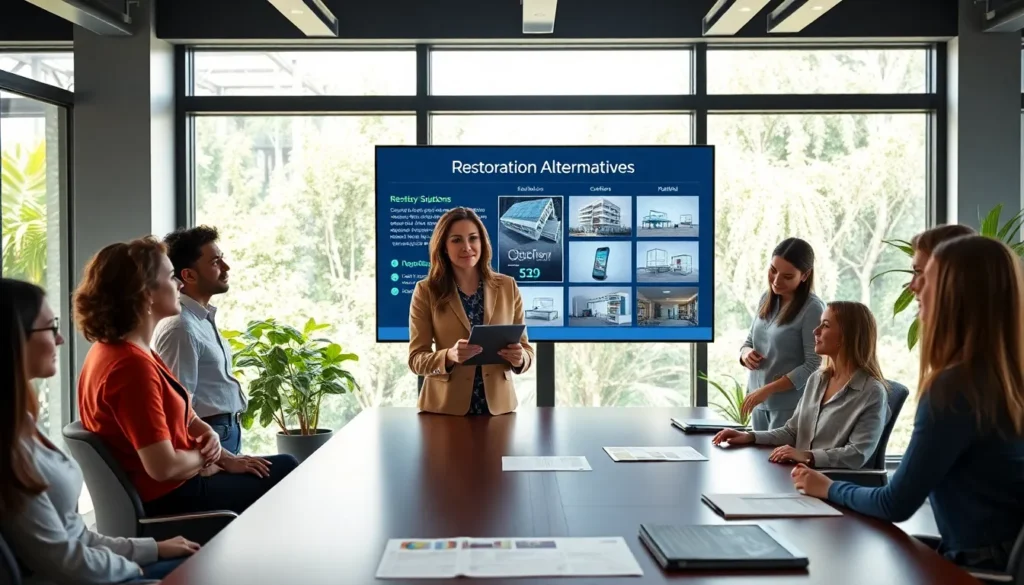In a world where DIY often leads to chaos and casualties, finding the right restoration alternative can feel like searching for a unicorn in a haystack. Luckily, WebBizMagnet is here to save the day, shedding light on smarter options. Whether it’s your home needing a little TLC or your favorite chair calling for an intervention, understanding modern restoration alternatives is your first step. With detailed insights and a touch of humor, this guide promises not only to educate but also to entertain, because restoration doesn’t have to be boring. So, buckle up as we jump into the top restoration alternatives that even your grandmother would approve of.
Table of Contents
ToggleUnderstanding Restoration Alternatives

Restoration alternatives come in many shapes and sizes, ranging from traditional methods that have stood the test of time to innovative solutions that are changing the landscape of restoration. Essentially, these alternatives seek to repair, refurbish, or rejuvenate items, spaces, or structures rather than discarding them. It’s about making informed choices that align with one’s budget, environmental concerns, and aesthetic preferences.
Often, the biggest misconception is that restoration means a one-size-fits-all approach. In reality, the field is as diverse as the objects it serves. From eco-friendly cleaning products to more advanced techniques, understanding these alternatives can redefine what restoration means for any individual or organization. Why throw something out when you can give it a second chance, right?
Benefits of Restoration Alternatives
Why should one bother with restoration alternatives? Well, the benefits can be quite compelling. First off, these methods often save significant money. Rather than engaging in the cost of brand-new items or renovations, restoration can be budget-friendly. Why replace when you can resurrect?
Next, let’s talk about the environment. Restoration alternatives often use sustainable practices that reduce waste and promote recycling. In a time when everyone is trying to be a bit more eco-conscious, restoration steps up as a fantastic option. Think of it as the greener sister of replacement.
Finally, there’s a unique charm and character that comes with restored items. Whether it’s a vintage sofa or an age-old family heirloom, a well-restored piece carries stories and memories that new items simply can’t replicate. It’s like an Instagram filter for your belongings, bringing out their best features while keeping their history intact.
Top Restoration Alternatives by WebBizMagnet
When it comes to top-notch restoration alternatives, WebBizMagnet has identified several standout options worth exploring.
1. Eco-Friendly Restoration Solutions
This option emphasizes sustainable practices and eco-friendly materials. Utilizing non-toxic paints, natural fibers, and organic solutions, these alternatives aim to protect both the objects and the planet. Eco-friendly restoration doesn’t sacrifice beauty either: with a little ingenuity and creativity, stunning results can emerge from this sustainable approach.
2. Traditional Restoration Methods
Sometimes, old is gold. Traditional methods, like handcrafting, careful refinishing, and classic repair techniques, have been trusted through generations. This approach values craftsmanship and often results in items that stand the test of time, not only in durability but also in aesthetic appeal. Who wouldn’t appreciate the charm of a hand-stitched chair or a meticulously refinished table?
3. Advanced Technology Integration
For those who prefer a tech-savvy approach, integrating advanced technology into restoration can yield astounding results. From 3D printing replacement parts for damaged items to using laser cleaning techniques that restore surfaces without damage, technology opens up new avenues. Embracing innovation in restoration carries the potential for precision and efficiency that traditional methods sometimes lack.
Comparing Cost-Effectiveness of Alternatives
Cost-effectiveness is often a major consideration for anyone exploring restoration alternatives. While traditional methods typically involve higher labor costs due to the time and skill required, they might be less pricey in the long run when compared to frequently replacing items.
Eco-friendly restoration can fit snugly within a budget, especially when one considers the potential savings from reduced waste and energy consumption. Technology-driven restorations may offer efficient solutions that save both time and money, but upfront costs can occasionally be higher. It often pays to conduct a thorough analysis to find which alternative yields the best balance between quality and cost. Remember, it’s not just about the initial price tag: enduring value is what truly counts.
Factors to Consider When Choosing Restoration Alternatives
Choosing the right restoration alternative isn’t just about flavor of the month: several factors need consideration. First, assess the condition of the item or space in question. Some alternatives might be better suited for a drastically damaged piece, while others work wonders on minor imperfections.
Next, budget constraints are crucial. As earlier highlighted, different methods come with varying price tags. Understanding what’s feasible can narrow down options. Also, the desired outcome should shape the decision: aesthetic preferences differ, and what works for one may not work for another.
Finally, consider the commitment required. Some restoration methods demand considerable time and patience while others yield quicker results. Aligning the right alternative with one’s resources and expectations will lead to a successful restoration experience.





